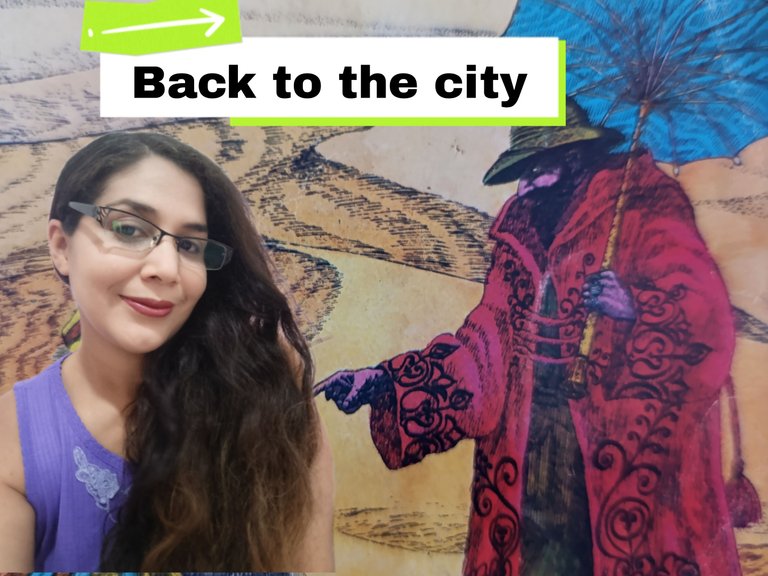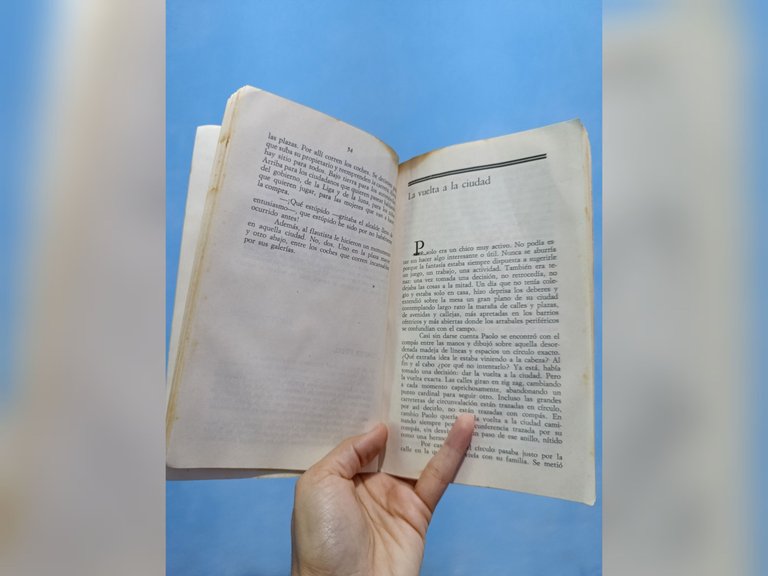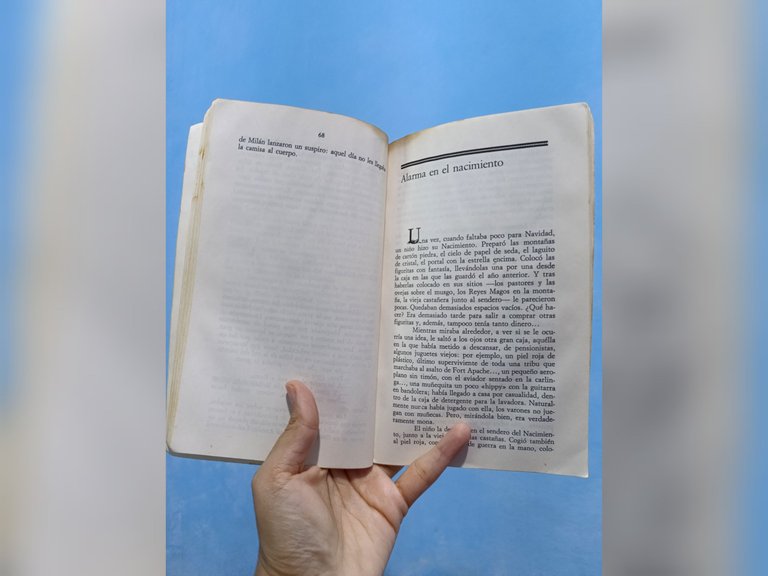I continue reading children's stories, I like them because they fill my days with optimism, as they are fresh and pleasant narrations, I also take the opportunity to tell some of them to little Alma and in this way I encourage her to learn to read and enjoy this privilege.
Today we will explore three other stories by Gianni Rodari. The first one is entitled Back to the city, the story introduces us to Paolo, a naïve and curious boy who one day took a map of the city and traced a circle with a compass as a route. When he began his journey, he realized that what he had drawn on the paper was far from what he found, since the road was full of obstacles. He had to jump over walls, climb roofs, cross a river...This highlights the perseverance of the protagonist to see his project come to fruition, despite the adversities.

The three alternative endings have two very interesting options, one suggesting that when it comes to setting goals one must be realistic, because a very distant and improbable goal often creates frustration and bitterness. Of course it must be explained to the children that in the real world magic or fantasy does not apply. The other ending that pleased me was the appearance of another child who asks Paolo for help to find his mother, for this reason he abandons his plan to complete the journey to help the little boy. Here, immediate help to others is presented to us as a priority, a value worth rescuing in these times.
The second story is entitled When it rained hats in Milan, the story is perhaps somewhat illogical, but being a children's story one must accept that anything is possible. The truth is that it rains hats of all kinds on Milan and people throw themselves to get the one they like the most, in this case they look for those that fit their personal traits. But despite being free, nonconformity and violence took over the atmosphere, generating fights when people wanted the hat that someone else had.

The endings proposed for this story are very ingenious, from a pilot who drops hats from an airplane to the rain of all kinds of objects, even washing machines and refrigerators, causing the bankruptcy of the merchants. The author's proposal in this story points to a social and ideological criticism that the fantasy masks, although, as he also stated, it is preferable that it rains hats than that a bombing takes place.
Similarly, Alarm at birth invites us to reflect. A Christmas nativity scene serves as the setting for a particular story. A child is organizing the Nativity Scene and notices that there are three empty spaces, so he places a toy in each one of them. Thus, an airplane with its pilot, a red-skinned Indian and a doll with a guitar appear next to the Virgin Mary, St. Joseph, Baby Jesus, shepherds, animals and other traditional elements that decorate a Nativity Scene.

When the child went to sleep, all the objects came to life and the conflicts between the characters and the toys began. Segregation, racism and discrimination appear in the story with the intention of drawing the attention of parents and teachers. The three alternative endings suggest that resolving conflicts of this nature requires decisions that are not always pleasant. The one that pleased me most deals with conciliation, through the intervention of the Magician King Gaspar. Another proposes that the pilot takes the Indian and the doll back to the box in the plane, a clear allusion to the rejection of immigrants. The third option is that the Indian becomes white so that the others can stay.
As can be seen, these three stories have a lot in common: they are based on a children's story and present situations to think about and feel identified with. While fantasy is there to shape the stories, the messages sent involve somewhat complex issues, from the conflictive society that struggles for what is free and also demands, to what is considered a priority in life, to the mistreatment for being different and how to deal with it.
Versión en EspañolSigo con la lectura de cuentos infantiles, me agradan porque llenan de optimismo mis días, al ser narraciones frescas y agradables, además aprovecho la ocasión de narrarles algunos a la pequeña Alma y de esta forma la incentivo para que aprenda a leer y disfrute de ese privilegio.
Hoy exploraremos otros tres cuentos de Gianni Rodari. El primero se titula La vuelta a la ciudad, la historia nos presenta a Paolo, un niño ingenuo y curioso que cierto día tomó un plano de la ciudad y trazó un círculo con un compás a modo de recorrido. Cuando inicia su travesía, observa que lo planteado en el papel está lejos de lo que encuentra ya que el camino está lleno de obstáculos. Debía saltar paredes, trepar tejados, cruzar un río... Acá se resalta la perseverancia del protagonista por ver cumplido su proyecto, a pesar de las adversidades.

Los tres finales alternativos tienen dos opciones muy interesantes, uno sugiere que a la hora de plantearse objetivos hay que ser realistas, porque una meta muy lejana e improbable suele crear frustraciones y amarguras. Por supuesto hay que explicarle a los niños que en el mundo real no aplica la magia o la fantasía. El otro final que me agradó fue la aparición de otro niño que le pide ayuda a Paolo para encontrar a su mamá, por tal razón abandona su plan de completar el recorrido por socorrer al pequeño. Acá la ayuda inmediata al prójimo se nos presenta como prioridad, un valor que valdría la pena rescatar en estos tiempos.
El segundo relato se titula Cuando en Milán llovieron sombreros, la historia es quizás algo ilógica, pero al ser un cuento infantil se debe aceptar que todo es posible. Lo cierto es que sobre Milán llueven sombreros de todo tipo y las personas se lanzan para obtener el que más le agrada, en este caso buscan los que se ajustan a sus rasgos personales. Pero a pesar de ser gratuitos, la inconformidad y la violencia se apoderaron de la atmósfera, generando peleas al desear el sombrero que alguien más tenía.

Los finales propuestos para este relato son muy ingeniosos, desde un piloto que deja caer los sombreros desde un avión hasta lluvia de todo tipo de objetos, hasta lavadoras y refrigeradores, propiciando la quiebra de los comerciantes. La propuesta del autor en este cuento apunta hacia una crítica social e ideológica que la fantasía enmascara, aunque como también lo manifestó, es preferible que lluevan sombreros a que se produzca un bombardeo.
De igual manera, Alarma en el nacimiento nos invita a reflexionar. Un pesebre decembrino funciona como escenario para plantear una historia particular. Un niño está organizando el Nacimiento y observa que han quedado tres espacios vacíos, así que en cada uno de ellos coloca un juguete. De esta forma, un avión con su piloto, un indio piel roja y una muñeca con guitarra aparecen junto a la Virgen María, San José, el Niño Jesús, pastores, animales y demás elementos tradicionales que adornan un Nacimiento.

Cuando el niño se fue a dormir, todos los objetos cobraron vida y empezaron los conflictos entre los personajes y los juguetes. La segregación, el racismo y la discriminación aparecen en el relato con la intención de llamar la atención de padres y maestros. Los tres finales alternativos sugieren que la resolución de conflictos de esta índole requiere de decisiones que no siempre resultan agradables. El que más me agradó trata de la conciliación, mediante la intervención del Rey Mago Gaspar. Otro propone que el piloto se lleve en el avión al indio y a la muñeca de regreso a la caja, clara alusión al rechazo hacia los inmigrantes. La tercera opción es que el indio se transforme en blanco para que los demás puedan quedarse.
Como se advierte, estos tres cuentos tienen mucho en común y es que a partir de un relato infantil se presentan situaciones para pensar y sentirse identificados. Si bien la fantasía está allí para dar forma a las historias, los mensajes que se envían involucran temas un tanto complejos, desde la sociedad conflictiva que pugna hasta por lo que es gratis y además exige, pasando por lo que se considera prioritario en la vida, hasta llegar al maltrato por ser diferentes y cómo afrontarlo.
✓Photos from my personal gallery, edited with Fotocollage.
✓Text translated with DeepL.
🌟❤️🌟❤️🌟❤️🌟❤️🌟❤️🌟
✓Fotos de mi galería personal, editadas con Fotocollage.
✓Texto traducido con DeepL.
Posted Using INLEO